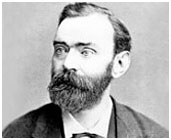Alfred Noble is the inventor of dynamite. To know more about his childhood and profile, read the biography given below.
Alfred Noble
Born on: October 21, 1833

Born in: Stockholm, Sweden
Nationality: Swedish
Career: Chemist, Engineer, Innovator, Armaments Manufacturer and the Inventor of Dynamite
Death: December 10, 1896
Alfred Noble is more popularly known as the inventor of dynamite. Swedish by origin, he was a chemist, engineer, innovator as well as an armaments manufacturer. He even owned Bofors, a major armaments manufacturer, which was previously an iron and steel mill. Noble is accredited for laying the foundation of Noble prize distribution amongst people, for their significant contribution to various fields. As a form of commemoration, the synthetic element ‘nobelium’ was named after him.
Childhood
Alfred Noble was born as ‘Alfred Bernard Noble’ on 21st October 1833, in Stockholm, Sweden. He was the third son of Immanuel Nobel and Andriette Ahlsell Nobel. In 1842, he moved with his family to St. Petersburg, where his father started torpedo works. His father was the inventor of modern plywood. After the bankruptcy of the family business, Alfred returned to Sweden and started studying explosives, especially the safe manufacture and use of nitroglycerine. This led to several explosions at their family-owned factory in Heleneborg. One of them, which occurred in 1864, was so disastrous that it killed his younger brother Emil as well as many workers.
Discovery of Dynamite
Noble discovered that when nitroglycerine was incorporated in an absorbent inert substance like kieselguhr, it became safer and more convenient to handle it. He got this mixture patented as dynamite in 1867. In the same year, he demonstrated his explosive for the first time, at a quarry in Redhill, Surrey, England. Later, he combined nitroglycerine with another explosive called gun - cotton. This gave him a jelly-like substance, which was more powerful than dynamite. He patented it in 1876, with the name Gelignite or Blasting Gelatin.
Foundation of Nobel Prize
On 27th November 1895, Nobel signed his last will and testament, at the Swedish-Norwegian Club in Paris. In the will, he set aside a considerable amount of his estate for the establishment of the Noble Prizes. These accolades were to be given to eminent people, irrespective of the nationality, T for their contribution in different fields, such as physical science, chemistry and medical science or physiology; literary work and peace projects.
Death
Alfred Noble died of a heart stroke at Sanremo, Italy, on 10th December 1896. The fortune he left behind to fund the Noble Prizes amounted to 31 million kronor. Nobel is buried in Norra begravningsplatsen, in Stockholm. He also wrote Nemesis, a prose tragedy in four acts about Beatrice Cenci, partly inspired by Percy Bysshe Shelley's The Cenci, which was printed while he was dying. Though the entire stock was destroyed after his death, a remaining edition was published in Sweden, in 2003.
See also
More from iloveindia.com
- Home Remedies | Ayurveda | Vastu | Yoga | Feng Shui | Tattoos | Fitness | Garden | Nutrition | Parenting | Bikes | Cars | Baby Care | Indian Weddings | Festivals | Party ideas | Horoscope 2015 | Pets | Finance | Figures of Speech | Hotels in India : Delhi | Hyderabad | Chennai | Mumbai | Kolkata | Bangalore | Ahmedabad | Jaipur
- Contact Us Careers Disclaimer Privacy Policy Advertise With Us Lifestyle Sitemap Copyright iloveindia.com. All Rights Reserved.







